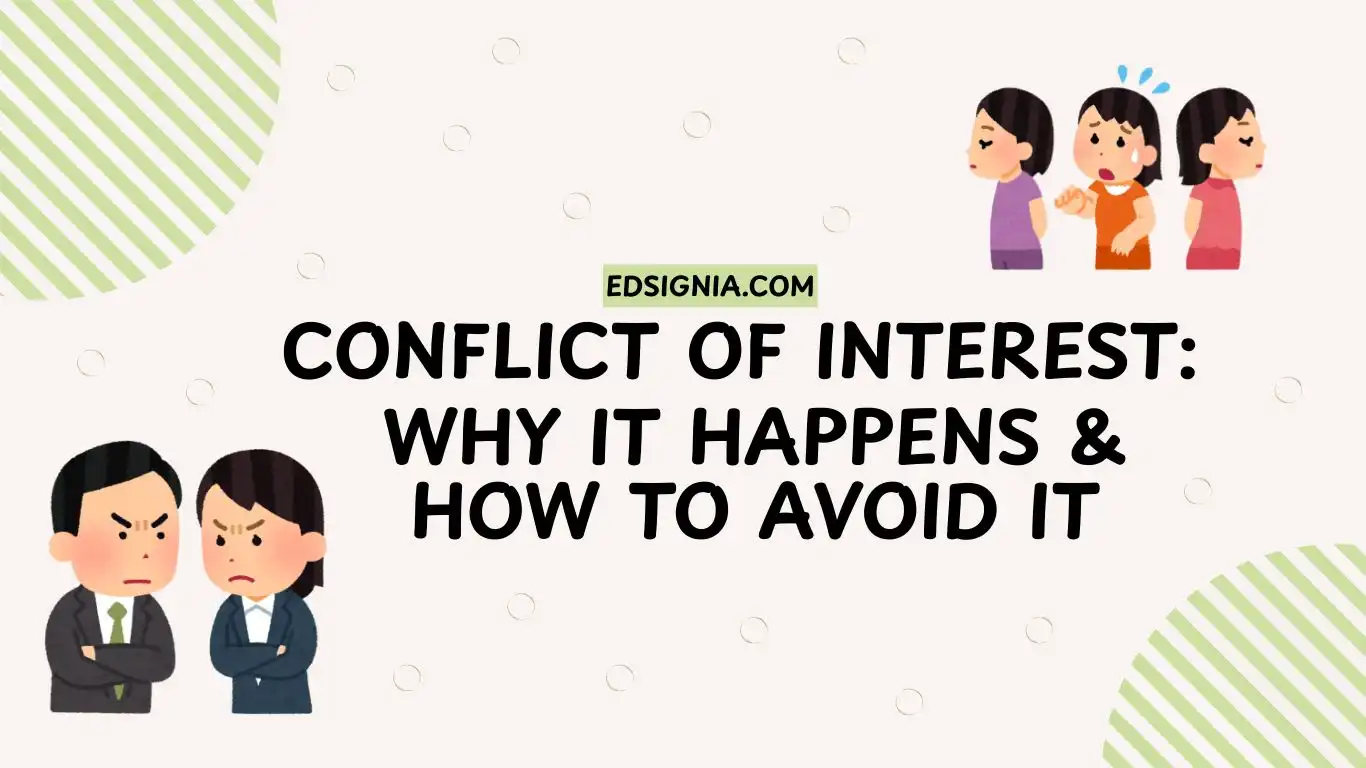Introduction
We will be taking a look at something which a lot of us have witnessed in our daily lives. You could have seen it happening at many different places such as the workplace, an educational institution, or a business meeting. The topic of our discussion today is none other than “Conflict of Interest”.
Conflict of interest refers to a phenomenon where an individual takes a decision keeping their personal interests in mind while not looking at the bigger picture. This can be attributed to many different factors. Some of these factors are the presence of familial ties, emotional attachment, cognitive biases, financial causes, etc.
Similar to other issues, conflict of interest does not exist in a vacuum. There are several reasons which give rise to such a situation, some may be intentional while the others unintentional. Let us take a closer look at how this situation emerges and what can be done to resolve it.
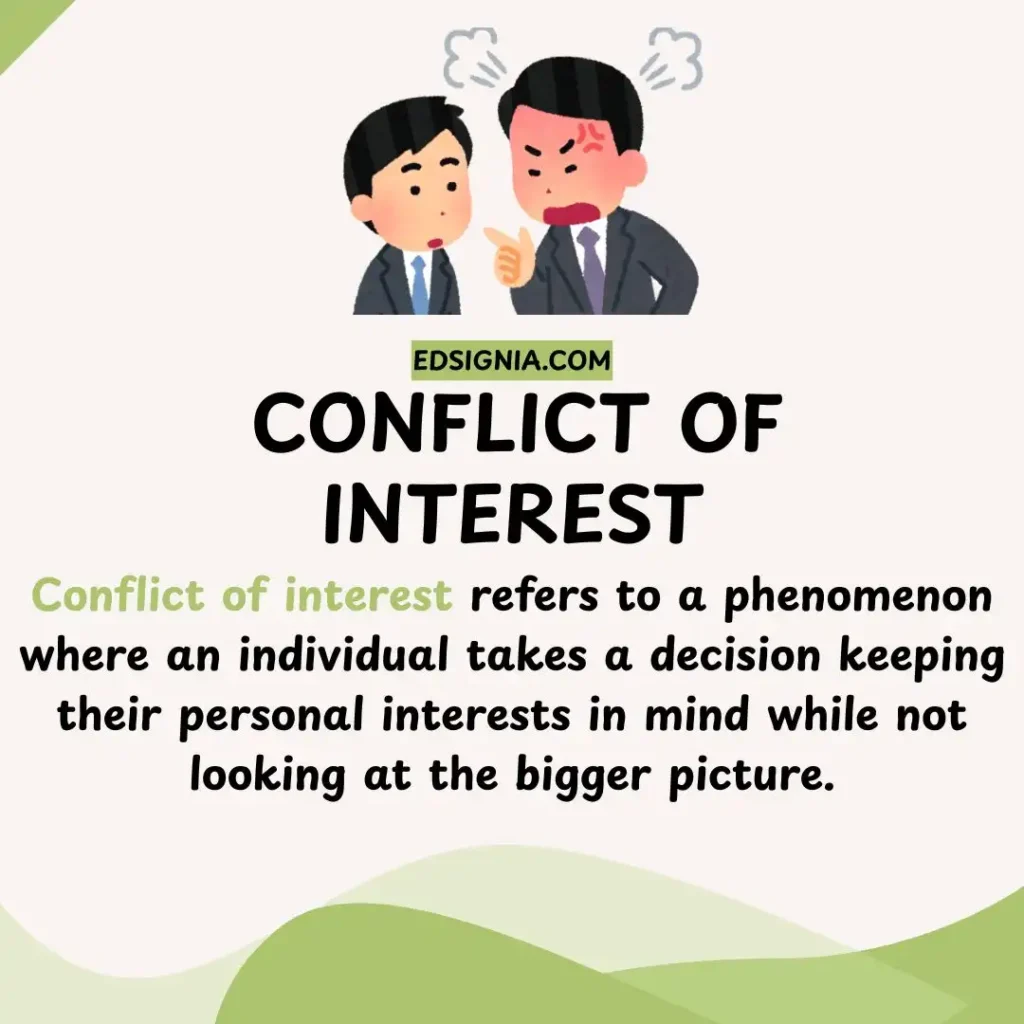
Why Do Conflicts of Interest Happen?
The “Why” question is the first to pop up in our minds. We tend to immediately start looking for answers whenever something irregular or unusual happens and it is the right thing to do. Let’s try to figure out the reasons behind the “conflict of interest” dilemma.
Financial Reasons
Oftentimes, money is the main determinant in a lot of scenarios and it can contribute to a conflict of interest as well. When there is financial compensation involved, an individual may make decisions which would yield the most return for them. To explain this better, we will be taking a look at an example to understand this better.
When the dean of a university is in contact with a major financial donor, they may choose to admit their ward without following a meticulous entrance process. As a result, the dean would have taken a wrong decision which could compromise the reputation of the institution. If this becomes a common occurrence, it can adversely affect the brand image of the entire university.
Formal or Informal Relationships
Relationships are a beautiful thing whether it is on a personal level or in a workplace setting but it does not come without a series of challenges. Oftentimes, a relationship has the potential to impair judgement and alter the entire course of action. There are a couple of examples which will explain how an innocent relationship can easily become a cause of concern in a formal setting.
Suppose someone works as an HR of an organisation and they are tasked with interviewing a family member, there is a clear conflict of interest. Similarly, if an individual opts to hire their partner in a business firm they own, it may not go well with the other employees in the company. Relationships are an important facet of our lives but improper integration with work may ring the nepotism alarm bells in full volume.
Opaqueness of Conduct
Transparency is a beautiful thing in life and it presents you in a positive light to your friends and peers. In the same way, opaqueness of conduct may raise suspicion about your behaviour even if nothing is wrong. This is even more true in a formal setting and there is an example which will highlight this fact.
If a business posts an advertisement about the openings they currently have but refuse to share the required qualifications, it poses a major risk. Employees would be unsure if they fulfill the required qualification or not and may not apply. This move risks alienating good talent and it can even portray the company as being deceptive which is not good for long term growth.
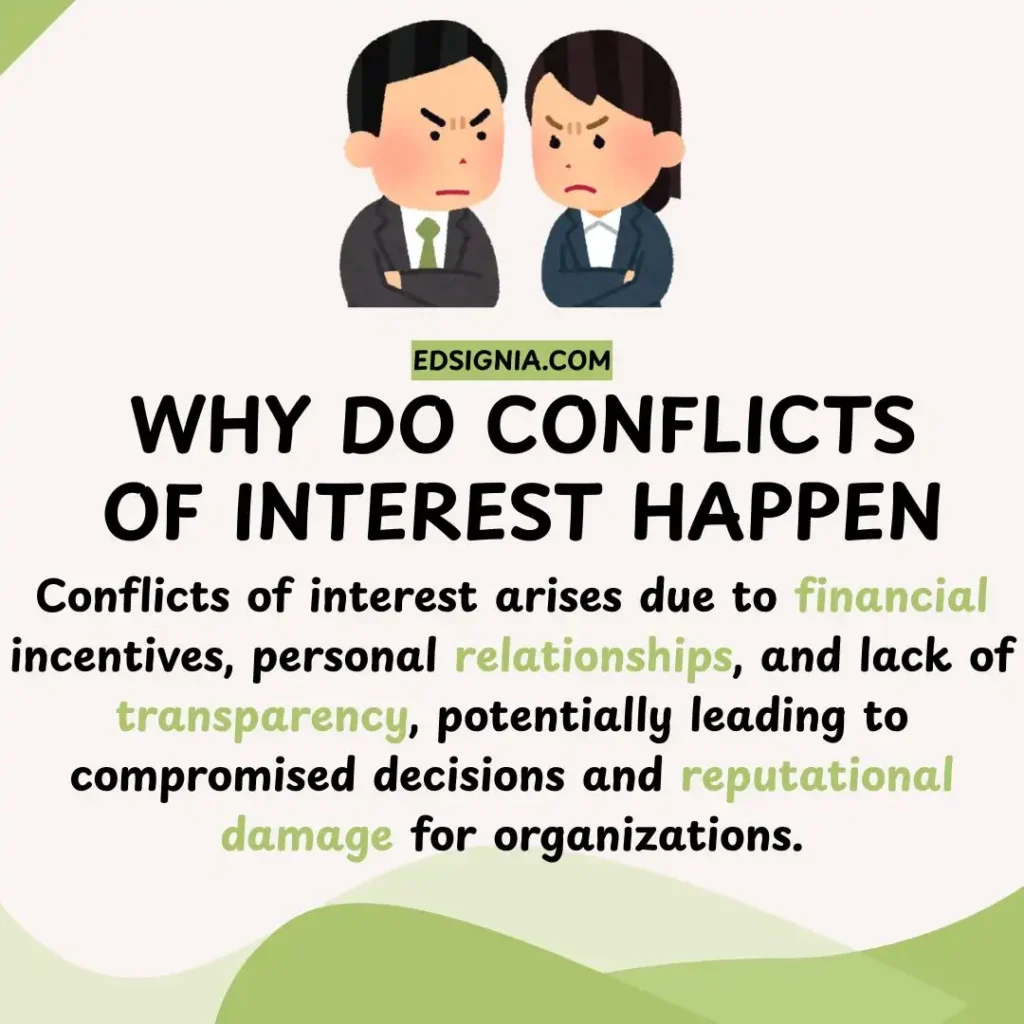
Pitfalls and Consequences
Humans are not inherently bad (or that’s what I believe in) and conflict of interest may not even be planned out of sheer malice in the first place. This does not mean that it can cause major issues which have the potential to cause great harm to the affected parties. Some of these issues are as follows.
Poor Decision Making
In a business setting, decision making skills are needed and managers are expected to make sound decisions under pressure. This is done as the stakes are high at all times and a wrong decision has the potential to push the company behind their nearest competitor. Conflict of interest has the potential to disrupt organisational growth and it can be demonstrated with a simple example.
When a senior level manager has major stakes in a competing business firm, their decision making would be compromised. In this case, the decision taken could be partial to their individual interests and will not be in the interest of the company where they are currently working. The result could be catastrophic for the business and corrective steps may take some time to yield results.
Loss of Goodwill
If an individual or a business faces allegations of being partial and dishonest, it can become quite a challenge to overcome. For an individual, they can lose recognition from their peer group and for an organisation, they can lose out on their loyal consumer base. The end result could be a major loss of goodwill so let’s take a look at an illustration to understand this concern.
Suppose there is a famous restaurant across the street which serves amazing food. One day, the manager decides to replace the head chef with a family member who can cook. This change will alter the quality of the food and as a result, the restaurant would lose out their loyal customers.
Legal Challenges
Getting in litigation is oftentimes the most glaring issue which can arise as a result of improper handling of the conflict of interest dilemma. The other challenges could be resolved with proper management but legal hurdles require a lot more effort and resources. We will now be taking a look at a short example to understand the severity of this issue.
If a medical professional compels their patients to purchase medicine from a supplier they are tied with, it can be a major conflict of interest. This can be a concern on different fronts. Apart from the loss of goodwill, the medical professional may face warning from the concerned regulatory board or council.
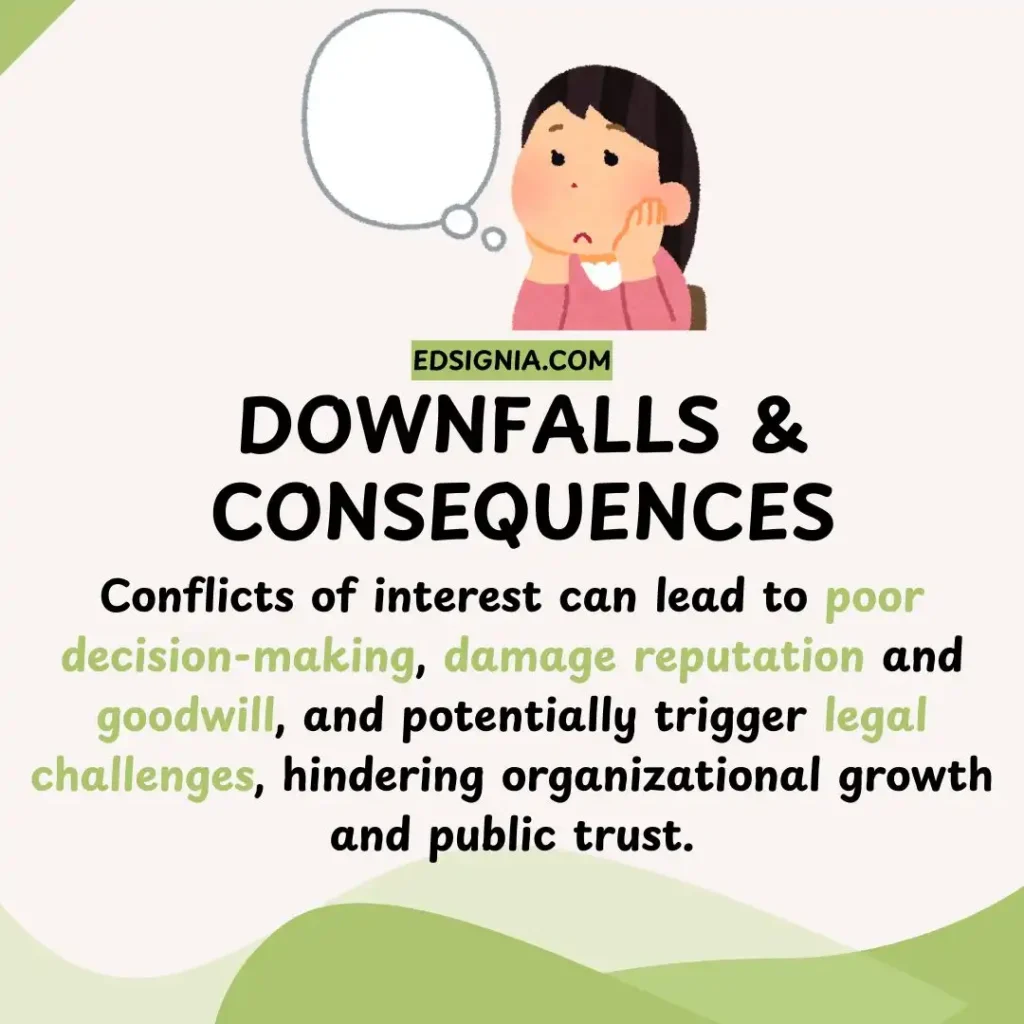
How to Avoid Conflicts of Interest?
After we get the initial answer for the “Why” question, our mind then shifts to the “How” question. When we find the reason behind a problem, we now need to find the solution to fix it. To do this, we will be taking a look at how we can resolve the “conflict of interest” problem in an apt manner.
Full Disclosure Principle
An easy way to steer clear of conflict of interest allegations is to follow the full disclosure principle. Even if the conflict of interest is not inherently present, full disclosure principles will remove the remaining doubts as well. The business or the individual can choose to disclose all their affiliations and allegiances beforehand.
A clear example of full disclosure is present on our website itself. It is the cookie banner which popped up as soon as you loaded this article. It can be annoying but we are compelled to follow the principle of full disclosure. This keeps us compliant and allows us to bring interesting articles for you (our audience) to read.
Predefined Rules and Guidelines
In a business setting, a guidebook can be provided to every employee after their joining. It can mention the ethical code of conduct which is expected from everyone in the workplace. The top level management should lead by example and ensure the organisation treats everyone fairly.
If the employees feel that everyone is treated equally, it would boost the morale of the workforce. This will also help create a harmonious environment and increase organisational efficiency. Having a preset guidebook can ensure compliance and prevent conflicts of interest in the company..
Third Party Reviews
The best way to tackle any adverse situation is to create an action plan if things ever go wrong. However, there are certain circumstances where the individual or a company cannot resolve the situation on their own. In such a case, external assistance is required immediately.
This external assistance can be either in the form of a third party independent review or by utilizing anonymous surveys within the organisation. The additional help is needed for a simple reason which is to involve a party with no stake in the operations. It will ensure that they are completely impartial in the task assigned to them.
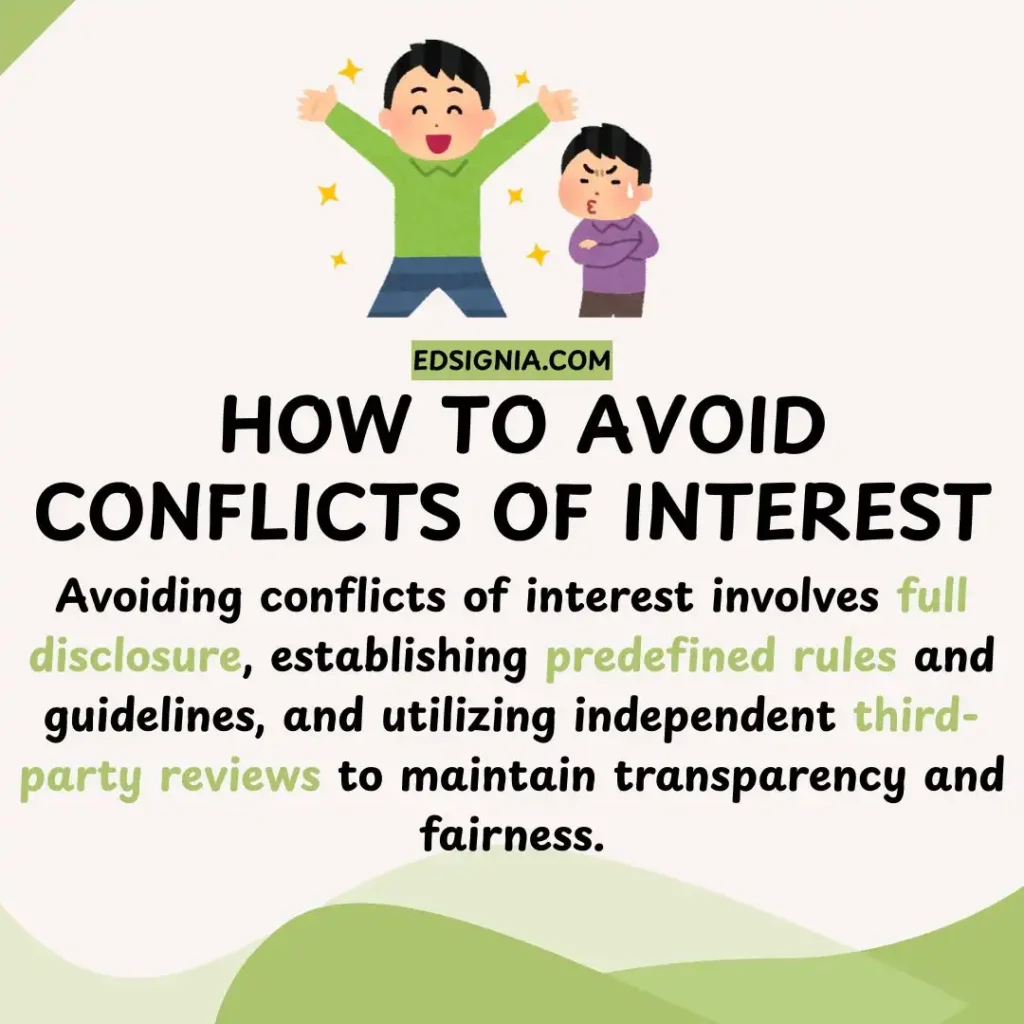
Conclusion
In this piece, we took a deep dive into how conflict of interest comes into play at many different places. We looked at the different reasons which give rise to this situation and how to tackle it. Along with this, we looked at certain examples in our day-to-day lives to better understand the problem as well as its solution.
To sum it all up, conflict of interest is a situation where an individual will have different interests and pursuing one will lead to sidelining the other. At an individual level, we can introspect and take an opinion from our loved ones to resolve this dilemma. On the larger level (in case of a business firm) a set framework will give ways for resolution if this issue ever arises.
If you found this article interesting or have any questions for us, feel free to drop them in the comments down below. You can also take a quick look at our other pieces on “Stagflation” or on “Strategic Human Resource Management” we published recently. Hope to interact with you soon with another interesting and informative piece.

